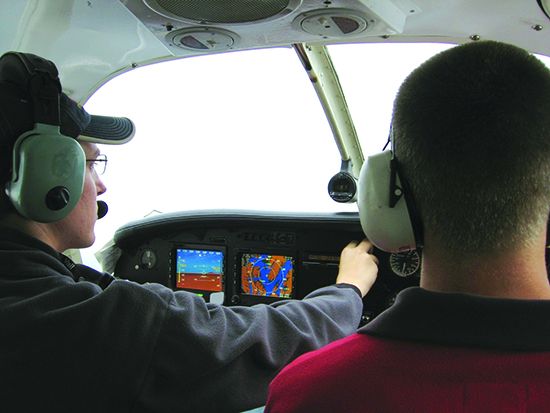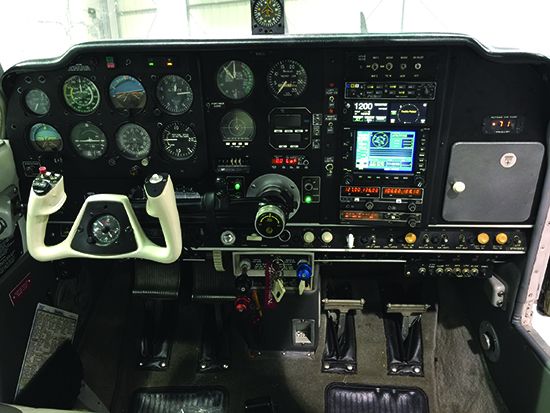
I saw it again on social media: someone posted that he/she is scheduled for a flight review and asked, “What should I study to prepare?” Generally well-meaning responses run the gamut from recommendations for classes or online courses, to a list of the available FAA manuals and advisory circulars (ACs), to statements like, “You can’t fail a flight review, so just show up without special preparation.” As is usually the case, the reality is some combination of these suggestions. What should (and can) you do to prepare yourself for a flight review? The answer: It depends on what you want to get out of it.
THE RULE
The regulation requiring a flight review every two years—biennially—is FAR 61.56 (the word “biennial” was removed from the requirement in 1997), and it is very simple: To act as pilot-in-command, a pilot must complete and log at least one hour each of ground and flight instruction from an authorized instructor (generally, a CFI) within the previous 24 calendar months. Ground instruction must include “the current general operating and flight rules of Part 91,” while flight training must cover “a review of those maneuvers and procedures that, at the discretion of the person giving the review, are necessary for the pilot to demonstrate the safe exercise of the privileges of the pilot certificate.” At its most basic, the flight review is a minimum-standards quality control check.
Preparing for this review means reading the portions of Part 91 applicable to the type of flying you do, and practicing stalls, steep turns, those emergency procedures that can safely be practiced in an airplane—basically, studying and practicing like you did for your private pilot checkride. It’s straightforward, but involved…and a bit dry. No wonder many pilots approach a flight review reluctantly or with trepidation. Instead of seeing the flight review as looking backward, embrace it as part of a personal continuing education program that teaches you new things and makes you an even more capable pilot, you might feel the flight review is more relevant and fun. This in turn changes the way you prepare for it.
INVOLVE YOUR INSTRUCTOR
Of course, your flight review will involve an instructor. But to best prepare for your flight review, begin talking to the instructor early. Tell them what you want to get out of your review, and then spend time together designing your review. For example, do something different. If you normally use your airplane for point-to-point travel, spend time on flight maneuvers. If you typically just fly around the local area, take a short cross-country. Include an introduction to commercial maneuvers (chandelles, lazy eights, etc.) even if you’re not a commercial pilot and don’t plan to pursue the certificate. Practice engine-out procedures (following safety protocols) and—at a safe altitude—simulated engine-out turnbacks to a runway to see if it’s even an option in the airplane you fly. Fly a short trip using pilotage. Land on a grass runway. Get some hood time if you’re a VFR-only pilot. Do something different, and when you debrief with your instructor after the flight, correlate what you learned (attitude control, airspeed control, division of attention, energy management, flight path management) to the type of flying you normally do.
Come up with an hour’s worth of exercises that teach you more about the handling and capability of your aircraft. You’ll quickly find you can’t do much in only an hour and want to schedule for more. Then prepare by watching online videos and courses (AOPA and EAA both have great video and webinar libraries online), reviewing the basics from the Airplane Flying Handbook and other FAA manuals (free online as well), and reading through your pilot’s operating handbook (POH) or airplane flight manual (AFM) for any guidance and limitations.
Don’t want to take a flight review? You have several alternatives. Like the flight review, each alternate requirement must have been completed within the previous 24 calendar months.
- Rated glider pilots may substitute a minimum of three instructional flights in a glider, each of which includes a flight to traffic pattern altitude, in lieu of the one hour of flight training required. FAR 61.56(b)
- Pass a pilot proficiency check or practical test conducted by an examiner, an approved pilot check airman, or a U.S. Armed Force, for a pilot certificate, rating, or operating privilege. FAR 61.56(d)(1)
- Pass a practical test conducted by an examiner for the issuance of a flight instructor certificate, an additional rating on a flight instructor certificate, renewal of a flight instructor certificate, or reinstatement of a flight instructor certificate. FAR 61.56(d)(2)
- Satisfactorily accomplish one or more phases of an FAA-sponsored pilot proficiency award program [FAA WINGS]. FAR 61.56(e)
- Holders of a flight instructor certificate who satisfactorily complete a renewal of a flight instructor certificate need not accomplish the one hour of ground training for a flight review but must still complete the flight training. FAR 61.56(f)
I also have a couple of personal observations as a 35-year flight instructor:
- Pilots who are required to pass annual or six-month checks for their employment meet the flight review requirement under FAR 61.56(d)(1). There is a significant difference, however, between flying a 737 or a A350 as part of a crew with the systems and redundancy of a transport aircraft under stringent rules and operations specifications, with the support of other professionals, and flying a simple or high-performance piston airplane as a single pilot with the loose requirements of Part 91 and being fully responsible for all aspects of flight planning and execution.
- Flight review requirements are not aircraft category- or class-specific. A flight review in a glider, or a free balloon, or an airplane, or powered lift, or seaplanes or landplanes or other, legally qualifies you to exercise pilot-in-command privileges in all categories and classes for which you are rated. You might consider, however, taking a flight review to confirm and enhance your skills in each of the categories and classes you fly.
FROM WEAKNESS,STRENGTH
Take advantage of the flight review opportunity by identifying any weaknesses in your skills, either from insufficient initial instruction or (more commonly) from atrophy as a result of lack of use. When you schedule your flight review, come to your instructor with a list of areas you’d like to improve. A great instructor will design scenarios that provide practice and permit instruction on techniques that address a weakness and turn it into your newest strength. Prepare by reviewing the skills on your list in the Airplane Flying Handbook and in your POH/AFM, and again, looking for reputable online content that provides suggestions for better flying these maneuvers.
FACE YOUR FEARS
Is there something about flying that scares you? Are you anxious about practicing stalls, for example? Uncomfortable operating at non-towered airports, or conversely, at airports in busy Class C or B airspace? Does your heart rate rise when landing or taking off from a runway less than 5000 feet long? Are steep turns outside your personal envelope?
The good news that at least twice in your life—on your private pilot checkride, and when you proved to your instructor you were ready before that—you demonstrated all these maneuvers to fairly tight standards. Typically, you did this with about 60 to 100 total flying hours, a neophyte. You have a lot more time now and these tasks should be easier, not harder for you…if you’ve practiced. Ask your instructor to design a flight review that refreshes your skill and creates comfort in your ability, to turn your fear into confidence. Using the same trilogy of FAA manuals, POH/AFM and online content, show up to your review prepared.

If you’ve not done so already, the flight review is a great opportunity to learn a new feature of your GPS, autopilot or other avionics. Practice using vertical navigation modes. See what the visual approach function of some navigators does, and practice using it. Explore hand-flying using the flight director. Confirm you know how each autopilot mode works. You won’t master everything on your panel in an hour (or so) on a flight review, but you can become proficient with one new thing, and then integrate it into your normal flying to develop mastery. Prepare for this type of flight review by reading the avionics manual, watching manufacturers’ videos and those of reputable vloggers, and even downloading and using often-free simulator software from avionics providers.
IPC AS AN FR?
Instrument-rated pilots often ask for an instrument proficiency check (IPC) and to endorse that flight as a flight review. This is permissible, although an IPC requires flying—to practical test standards—the tasks listed in the airman certification standards (ACS). It’s permissible because FAR 61.56 requires only an hour of flight instruction (in addition to the ground instruction requirement), without specifying any particular tasks to be flown or the standards for successful completion. It’s important to note a recent change now makes the ACS-listed tasks mandatory for an IPC.
However, FAR 61.56(h) removes any doubt about this, stating: “The [flight review] requirements may be accomplished in combination with the requirements of [the IPC requirement] and other applicable recent experience requirements at the discretion of the authorized instructor conducting the flight review.”
If you go this route, use caution, because 1) The flight instructor will have to log in your logbook that he/she has provided at least one hour of ground instruction on the extremely broad topics listed in the regulation (unless you use an alternative method; see the sidebar); and, 2) the instructor must specifically endorse your logbook for your flight review in addition to any endorsement for an instrument proficiency check. In other words, if it doesn’t say flight review in your logbook it wasn’t a flight review, even if you logged dual instruction.
I’ve seen many pilots who have used instrument training and IPCs for flight reviews, sometimes for a decade or more. These pilots are generally capable and smooth on the gauges but are often uncomfortable in anything steeper than a standard-rate turn and are surprised and behind the aircraft in low speed and high angle of attack maneuvers. Even in a standalone IPC, I generally include a go-around commenced from the landing flare, as well as a few other maneuvers that add little additional time but cover scenarios implicated in many aircraft accidents. Then, I’m happy to endorse the pilot for a flight review as well as an IPC, if earned.
DESIGN, AND PREPARE
Design a flight review that meets your needs and challenges you not only to confirm you fly safely, but that also teaches you something new. Define your goals, communicate with your instructor beforehand, seek out materials to help you prepare, and show up ready to learn. Don’t wait until flight review time to practice skills and seek out knowledge. Ultimately, every flight you make should be part of your preparation for your next flight review, by keeping you sharp and getting you ready to realize the full benefit of this “biennial” instruction.
Tom Turner is a CFII-MEI who frequently writes and lectures on aviation safety.



